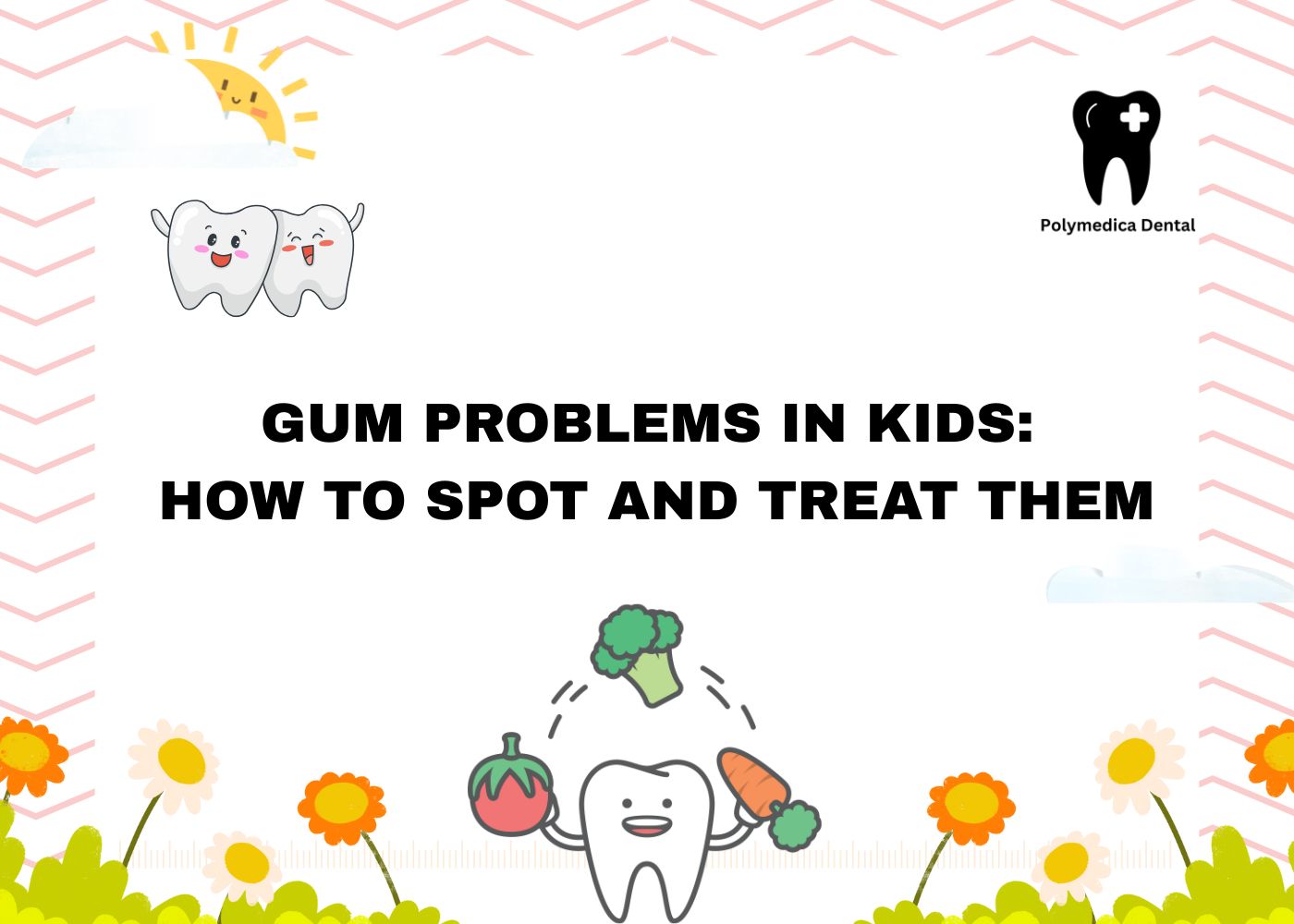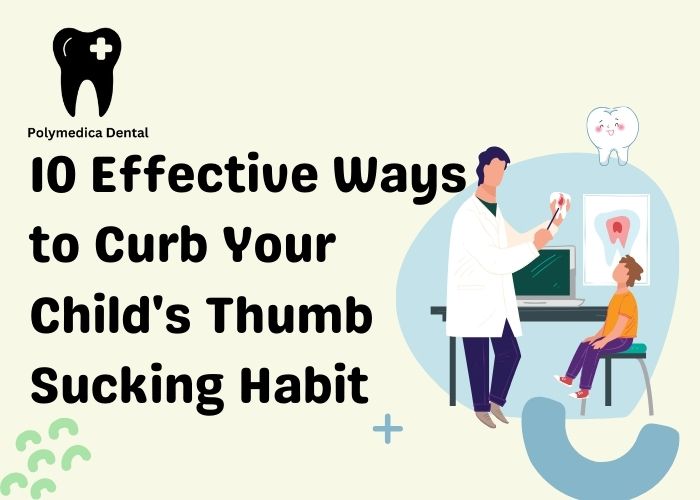

Thumb sucking is a common and natural habit among young children. It often begins in infancy as a self-soothing mechanism that provides comfort and security. Most kids naturally outgrow this habit by the age of 4 or 5. When thumb sucking continues beyond this age, it raises concerns due to potential impacts on dental health and speech development.
You might be wondering how to prevent thumb sucking habit for kids! Identifying effective ways to curb this behavior early is crucial to avoid complications such as misaligned teeth or jaw issues.
At Polymedica Dental and Medical Centre, Dr. Swati Pandey — recognized as one of the best kids dentists in Gurgaon — specializes in managing pediatric habits like thumb sucking. Their child-friendly approach ensures your little one receives expert care tailored to support healthy oral development while addressing thumb sucking concerns with patience and understanding.
Thumb sucking is a common comfort habit that often begins in infancy. It serves as a natural reflex for babies, providing self-soothing and security. This behavior helps infants feel calm and safe, especially when they are tired, anxious, or upset. The thumb sucking causes can be linked directly to the need for emotional comfort and stress relief in kids.
Most children stop thumb sucking between the ages of 2 and 4 without intervention. This natural cessation happens as they develop other coping skills and grow more independent. During this period, the habit generally fades as children find new ways to manage their emotions.
Stress or anxiety can trigger the resumption of thumb sucking even after it has stopped. For example:
In these situations, thumb sucking acts as a coping mechanism to ease tension. Recognizing these emotional triggers is important when addressing persistent thumb sucking habits. This understanding helps you approach the habit with empathy rather than frustration, setting the stage for effective support strategies.
Persistent thumb sucking beyond the typical age of 4 to 5 years can lead to several dental problems thumb sucking causes, primarily affecting the structure and alignment of your child’s teeth and jaw. The constant pressure from sucking alters the natural growth patterns of the mouth, resulting in:
The upper front teeth may be pushed outward, while the lower front teeth tilt inward, creating an open bite or overjet. This misalignment can interfere with biting and chewing efficiency.
Prolonged thumb sucking can affect how the jaws develop, potentially causing an improper bite relationship between the upper and lower jaws. This might lead to difficulties in speech articulation or discomfort when chewing.
Speech development concerns often accompany these dental changes. Extended thumb sucking may contribute to issues such as lisping or difficulty pronouncing certain sounds clearly. The altered positioning of teeth and tongue caused by thumb sucking can restrict normal tongue movement required for proper speech.
The longer this habit continues unchecked, the more complicated correction becomes. Early recognition of these potential problems allows you to seek timely advice from pediatric dental experts who specialize in managing habits that impact oral development.
Prevent thumb sucking early by introducing your child to other comforting items or activities. These alternatives can reduce reliance on thumb sucking as a soothing tool. Examples include:
Helping your child develop coping skills children need to manage emotions without thumb sucking makes a big difference. Stress and anxiety often trigger this habit, so guiding your child through healthier responses is essential. Techniques to try:
These approaches empower your child to identify and handle discomfort without returning to thumb sucking. Understanding how to prevent thumb sucking habit for kids involves patience and consistent support as they learn new ways to self-soothe. Creating a positive, reassuring environment where your child feels heard helps make these alternative coping mechanisms effective and sustainable.
Setting clear boundaries around thumb sucking helps your child gain control over the habit without feeling deprived. You can implement this stop thumb sucking tip by designating certain times or places where thumb sucking is allowed, gradually reducing its frequency.
Examples include:
This approach respects your child’s need for comfort while encouraging them to break the habit in other contexts. It also creates natural opportunities for your child to practice not sucking their thumb, building confidence and awareness of the behavior.
Use consistent reminders about these limits in a calm, supportive tone. Visual cues such as charts or gentle alarms can reinforce the boundaries without pressure. When your child follows these guidelines successfully, recognize their effort with praise to strengthen positive behavior.
Limiting thumb sucking in this way serves as a practical step between unrestricted sucking and full cessation. It works best when combined with other strategies like providing alternative coping mechanisms and positive reinforcement.
Positive reinforcement plays a crucial role in helping your child reduce or stop thumb sucking. Praising your child for going a certain period without sucking their thumb encourages them to continue this behavior. Instead of focusing on punishment or negative feedback, celebrate small victories to build confidence and motivation.
You can create a simple reward system such as:
Introducing substitute soothing items can complement positive reinforcement. Offer alternatives like a soft blanket, stuffed animal, or sensory toy when your child feels the urge to suck their thumb. This helps redirect the habit toward healthier comfort objects.
Encouragement combined with tangible rewards helps children feel supported rather than pressured, making it easier for them to make progress at their own pace. Keep track of improvements and adjust rewards as needed to maintain their interest and enthusiasm in breaking the habit.
When other techniques to stop thumb sucking don’t seem effective, you might explore gentle deterrent methods. One common approach is using bitter nail polish for thumb sucking. This specially formulated polish has a safe but unpleasant taste designed to discourage your child from putting their thumb in their mouth.
Consider these points when applying bitter-tasting nail polish:
This approach works best if your child is old enough to grasp why it’s being used and can cooperate. For younger children or those sensitive to new sensations, it may cause frustration, so monitor their responses closely.
If you’re wondering how to prevent thumb sucking habit for kids! beyond this, bitter nail polish offers a practical option without imposing harsh consequences. Its effectiveness lies in gently interrupting the habit loop while you continue supporting your child through alternative coping strategies and encouragement.
Use deterrents like bitter nail polish thoughtfully, always prioritizing your child’s comfort and emotional well-being during the habit-breaking process.
Parental support plays a crucial role in helping children overcome thumb sucking. Your approach can make a significant difference in how quickly and comfortably your child moves past this habit.
Here are some ways you can support your child:
Your role as a patient and understanding caregiver increases the chances that your child will successfully let go of thumb sucking in a healthy way. You provide the emotional foundation needed for change without adding pressure that could backfire.
Knowing when to seek a pediatric dental consultation is crucial for managing your child’s thumb sucking habit effectively. Certain indicators signal the need for professional evaluation:
At Polymedica Dental Centre, Dr. Swati Pandey offers comprehensive assessment and treatment plans designed specifically for children. Her approach includes:
Dr. Swati Pandey’s expertise helps parents understand the impact of thumb sucking on oral health while providing supportive, child-friendly care that promotes lasting change.
Polymedica Dental and Medical Centre stands out for its child-friendly environment, designed to make young patients feel comfortable and secure during their visits. The clinic offers a wide range of services tailored specifically for children’s dental health, ensuring that care is both professional and compassionate.
Dr Swati Pandey is recognized as one of the best kids dentists in Gurgaon, with extensive experience in managing pediatric dental habits like thumb sucking. Her approach focuses on gentle guidance and personalized treatment plans that address both the physical effects and emotional aspects of habit cessation.
Parents seeking advice on how to prevent thumb sucking habit for kids! find expert support here. Polymedica Dental Centre services include thorough assessments, early intervention strategies, and ongoing monitoring to promote healthy oral development. Choosing Dr Swati Pandey means partnering with a trusted specialist who understands the complexities of childhood habits and dental care.
Helping your child curb their thumb sucking habit requires patience, understanding, and consistent support. You play a crucial role as a partner in guiding them through this change gently and positively. Remember these key points for how to prevent thumb sucking habit for kids!:
Supporting your child with empathy creates a safe environment where they feel motivated to break the habit naturally. Your involvement sets the foundation for healthier oral habits and overall well-being, making this journey smoother for both of you.
WhatsApp us